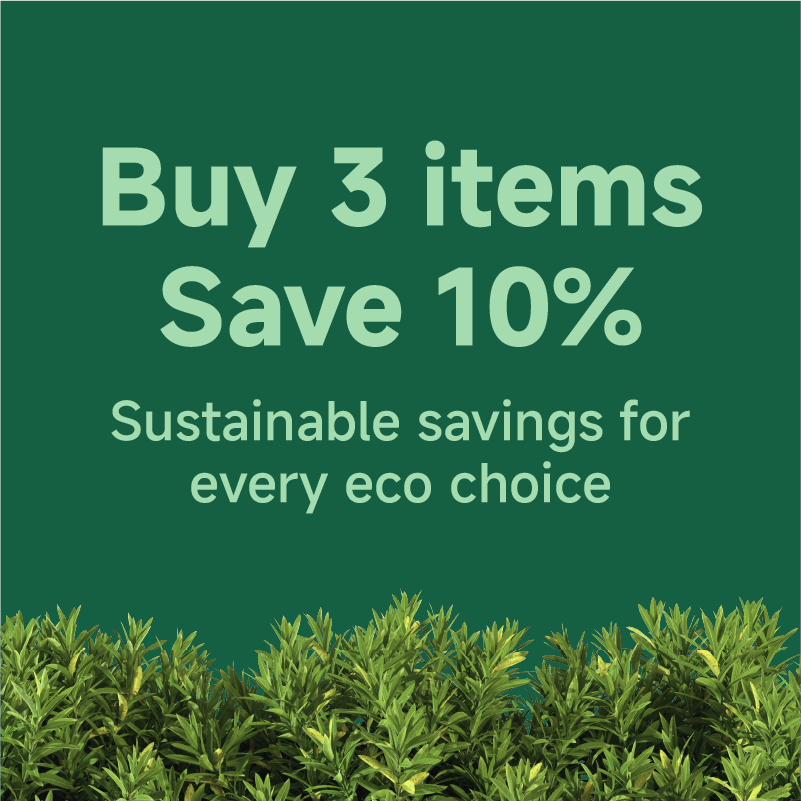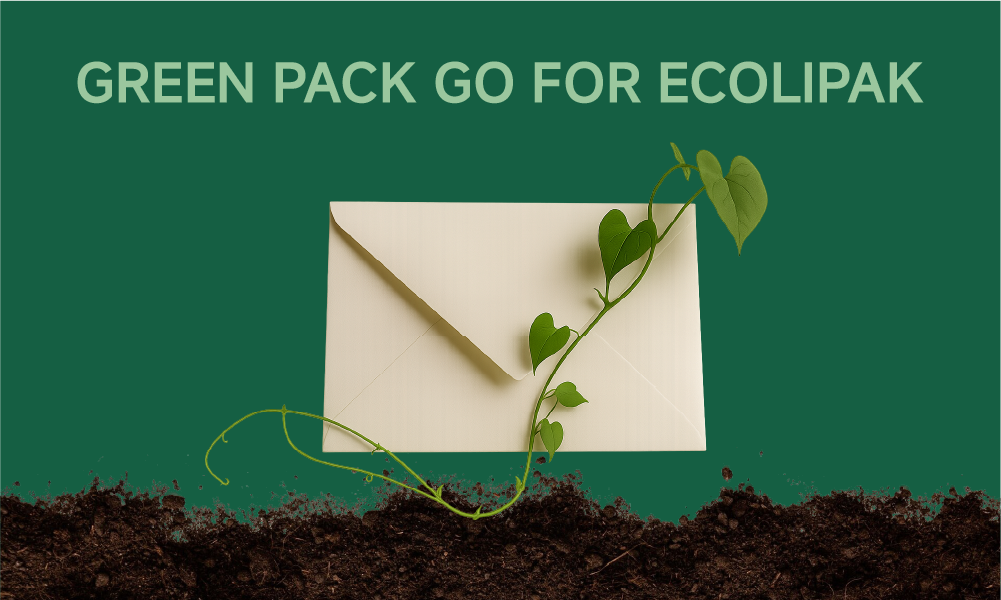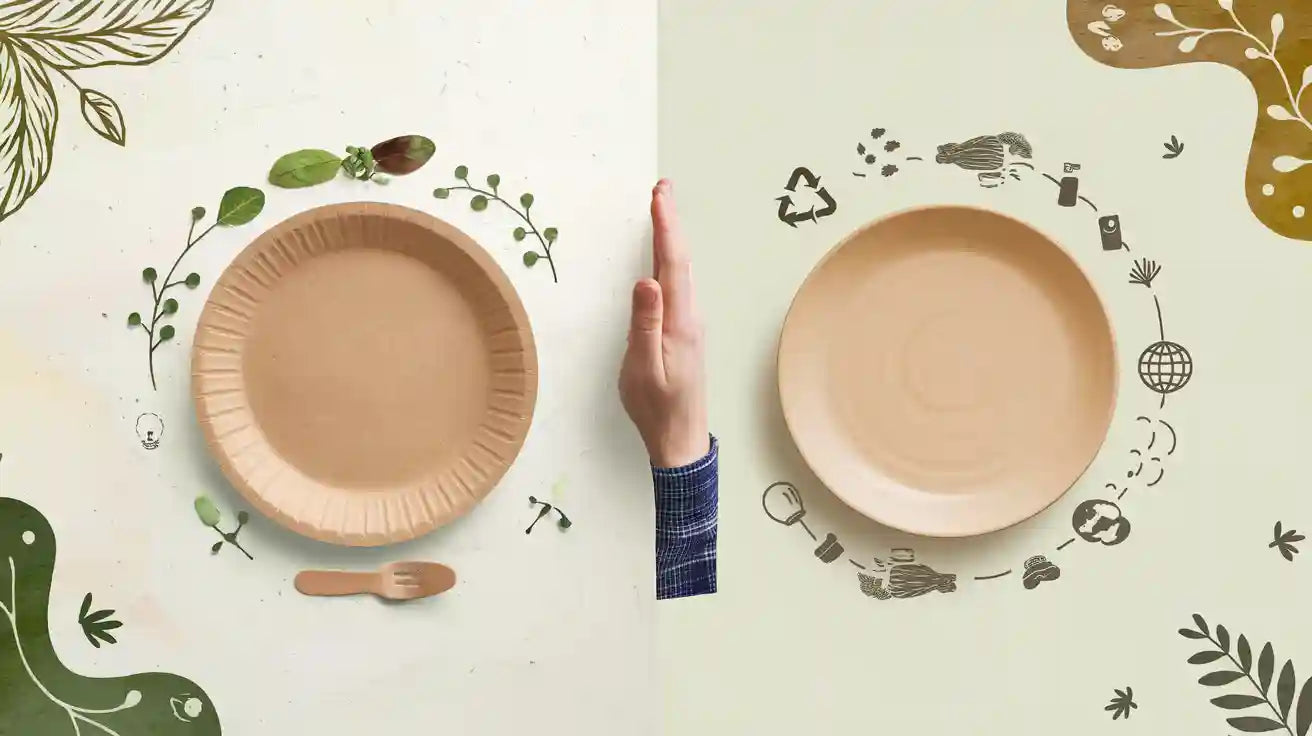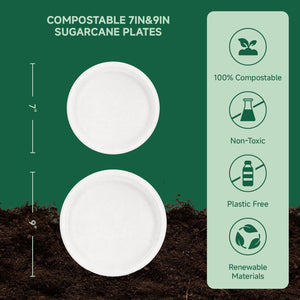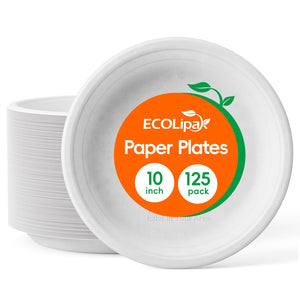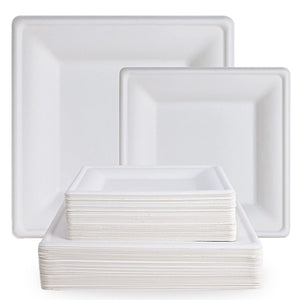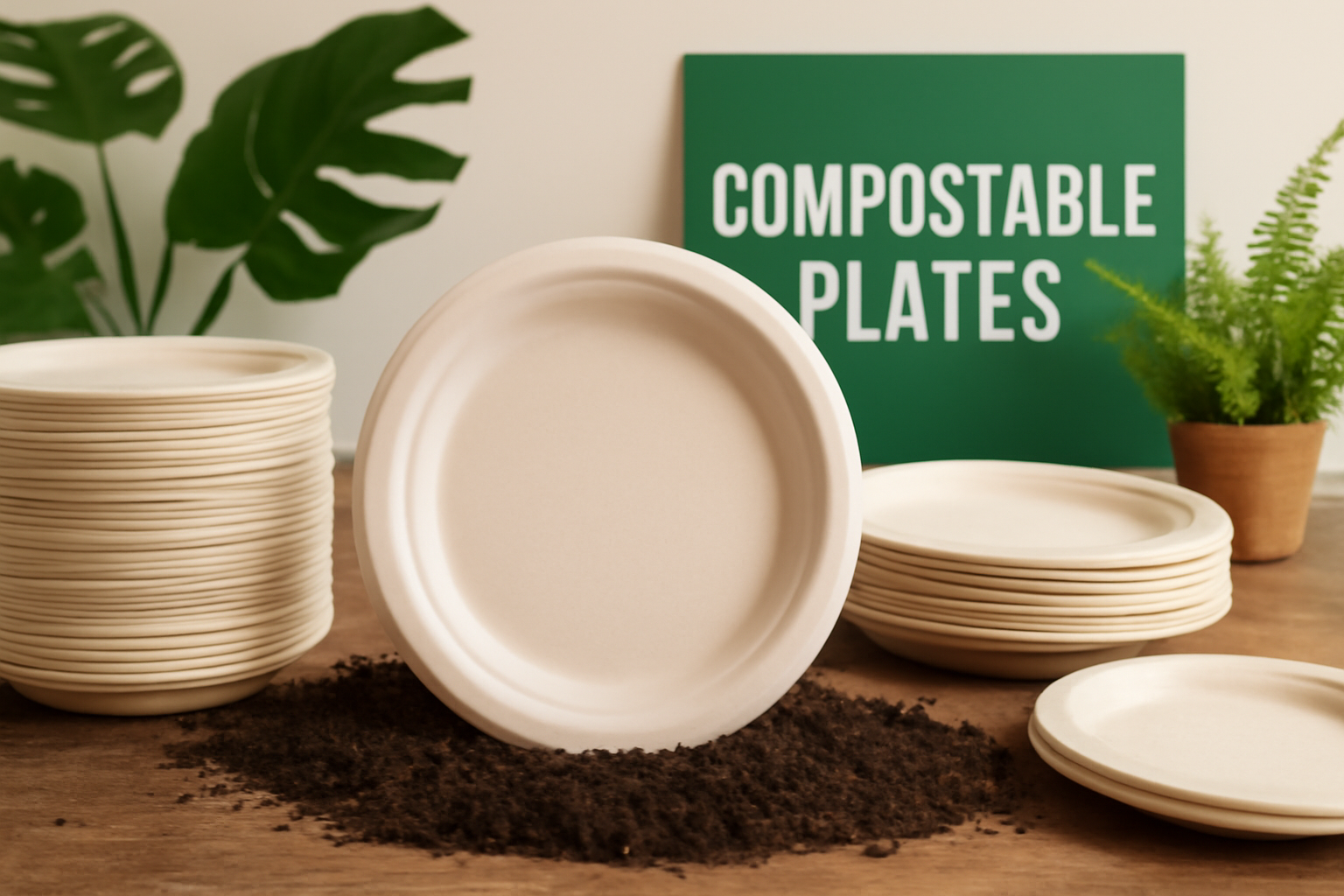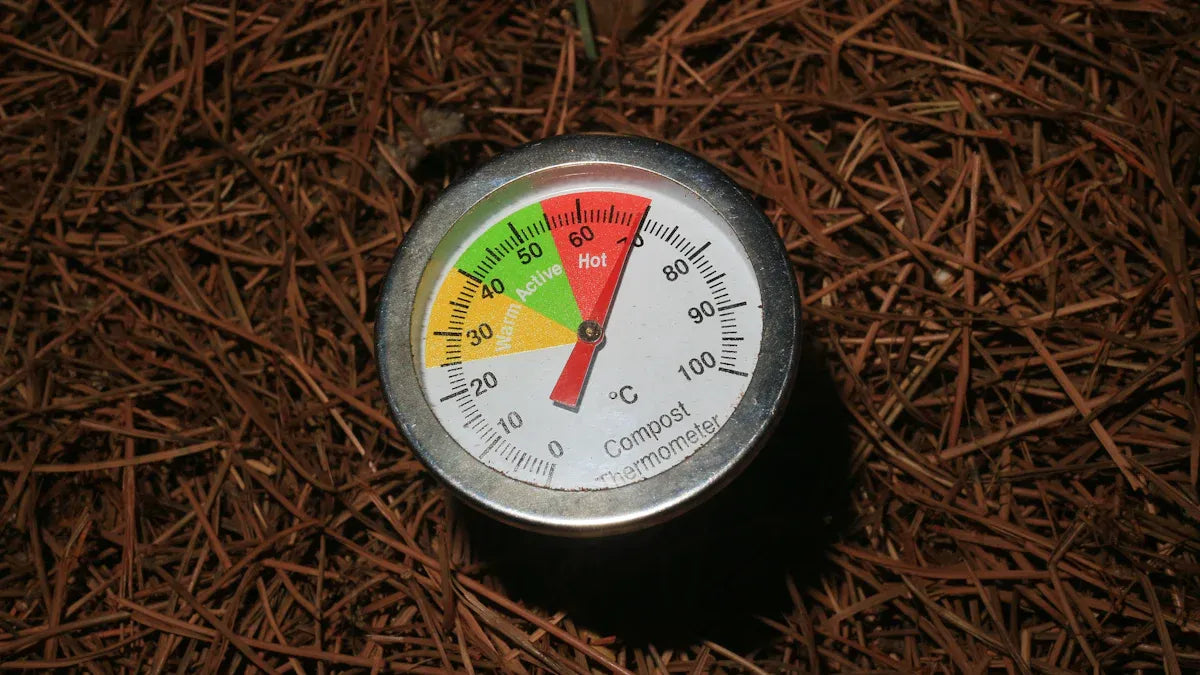You want to protect the planet and make eco-friendly choices at home or at events. Biodegradable paper plates, especially those made from sugarcane bagasse, show a much lower impact on the environment than traditional plates. These plates break down quickly and use renewable resources, while traditional plates need more energy and chemicals. Ecolipak leads the way in eco-friendliness by offering sturdy, compostable tableware. If you care about health and the future, consider both environmental and practical benefits.
|
Plate Type |
Waste Reduction |
Carbon Emissions Reduction |
|---|---|---|
|
Biodegradable molded pulp tableware |
Up to 70% |
— |
|
Compostable tableware |
— |
60% |
|
Food service use |
50% |
— |
Key Takeaways
-
Choosing biodegradable paper plates significantly reduces waste and carbon emissions, making a positive impact on the environment.
-
Ecolipak's compostable sugarcane plates break down quickly, returning nutrients to the soil and avoiding harmful chemicals found in traditional plastics.
-
Look for eco-friendly certifications like ASTM D6400 or EN 13432 to ensure you are selecting truly sustainable products.
-
Using compostable plates at events helps lower landfill waste and supports a cleaner environment for future generations.
-
Buying eco-friendly plates in bulk can save money and reduce packaging waste, making sustainable choices more accessible.
Environmental Impact
Biodegradable Paper Plates vs. Traditional Plates
You make a big difference when you choose what kind of disposable plates to use. Biodegradable paper plates and compostable plates come from plants, like sugarcane or bamboo. These materials grow back quickly and do not harm the planet as much as plastic. Traditional disposable plates, especially plastic ones, use oil and chemicals. They take hundreds of years to break down. When you throw them away, they often end up in landfills or oceans, where they hurt animals and pollute water.
Ecolipak works hard to lower the environmental impact of disposable plates. The company uses sugarcane bagasse, which is a leftover part of the sugarcane plant. This means less waste and more use of renewable resources. In 2024, Ecolipak sold over 59 million eco-friendly products. This helped protect 125,000 square meters of green space. You help the planet every time you pick a plate made from plants instead of plastic.
Government rules also help you make better choices. Programs like the USDA BioPreferred program and EU biobased product labeling make it easier to find real biodegradable paper plates and compostable plates. These programs check products and give them special labels. You can trust these labels when you shop.
|
Program/Policy |
What It Does |
|---|---|
|
USDA BioPreferred program |
Gives a guide for certified biobased products, helping you choose better |
|
Certification transparency |
Shows you which products are truly sustainable |
|
EU biobased product labeling |
Promotes renewable resources and helps you find compostable plates |
When you look at the pollution from traditional disposable plates, you see many problems. Plastic plates add to ocean debris and hurt sea life. They often have harmful chemicals like BPA. Some plastics even use land that could grow food. Biodegradable paper plates and compostable plates avoid these problems. They use fewer chemicals and do not stay in the environment for a long time.
|
Aspect |
Traditional Plastics |
Bioplastics |
|---|---|---|
|
Pollution |
Adds to ocean debris, harms marine life |
Can lower pollution levels |
|
Toxicity |
Has harmful additives like BPA and phthalates |
Usually has fewer harmful additives |
|
Agricultural Impact |
Uses land that could grow food |
Uses non-food feedstocks to avoid this problem |
Compostable Plates and Landfill Waste
You want to know what happens after you throw away your disposable plates. Compostable plates and biodegradable paper plates break down much faster than traditional disposable plates. In a compost pile, these plates turn into soil in a few months. This helps plants grow and keeps waste out of landfills. Traditional disposable plates, especially plastic ones, do not break down. They sit in landfills for hundreds of years and take up space.
Ecolipak’s compostable plates give you a way to help the planet every day. When you use these plates, you send less trash to the landfill. You also help lower carbon emissions because these plates come from plants, not oil. Many cities now collect compostable plates with food scraps. This makes it easy for you to do the right thing.
You can see the difference in numbers. Biodegradable molded pulp tableware can cut waste by up to 70%. Compostable plates can lower carbon emissions by 60%. Food service use of these plates can reduce waste by 50%. These numbers show that your choice matters.
Tip: Always check for compostable labels when you buy plates. This helps you make sure you are picking the best option for the planet.
When you choose compostable plates and biodegradable paper plates, you protect the earth for your family and future generations. You also support companies like Ecolipak that care about the environment. Every small choice adds up to a big change.
Sustainability Factors
Resource Use and Production
You might wonder how much energy and water go into making different types of plates. The production of biodegradable paper plates often uses a lot of water and energy. This process can also lead to deforestation and habitat loss, especially when companies harvest trees for paper pulp. The bleaching process for these plates sometimes uses chemicals like chlorine, which can harm the environment.
When you look at compostable sugarcane plates, you see a different story. These plates use bagasse, a byproduct left after extracting juice from sugarcane. Using bagasse means you do not need to cut down extra trees. This material comes from plants that grow back quickly, making it a sustainable alternative to wood pulp.
Here is a quick comparison of energy use:
|
Aspect |
Statistic |
|---|---|
|
Energy Consumption |
65% less than plastic manufacturing |
You help the planet when you choose products that use less energy and water. Compostable sugarcane plates stand out as a sustainable choice because they use fewer resources and avoid harmful chemicals.
Note: Choosing products made from renewable resources helps protect forests and reduces pollution.
Ecolipak Compostable Sugarcane Plates Example
Ecolipak’s compostable sugarcane plates show what a sustainable alternative can look like in your daily life. These plates use sugarcane bagasse, which would otherwise go to waste. By turning this byproduct into sturdy plates, Ecolipak supports a circular economy and reduces landfill waste.
You benefit from several environmental advantages when you use these plates:
-
Sugarcane bagasse is biodegradable and breaks down in 90 to 180 days under composting conditions.
-
Plates made from bagasse reach about 95% biodegradation in six months, while plastics can take centuries.
-
The cultivation and use of bagasse lower carbon emissions by up to 97% compared to traditional plastic manufacturing.
-
Bagasse is a renewable resource, so it helps reduce deforestation.
-
These plates do not release harmful substances as they break down. They turn into water, carbon dioxide, and biomass, which can improve soil quality.
Bagasse-based products now make up more than half of the eco-friendly plate market. In 2024, they accounted for 58.78% of the market. This growth shows that more people like you want a sustainable choice for their homes and events.
|
Evidence Description |
Impact on Market Trends |
|---|---|
|
The availability of sustainable raw materials has led to the introduction of eco-friendly products. |
Increased demand for biodegradable and eco-friendly disposable tableware. |
|
Government support for eco-friendly products is influencing consumer choices. |
Consumers are increasingly opting for sustainable alternatives, driving market growth. |
|
Innovations in biodegradable tableware are addressing existing challenges. |
Enhanced product offerings are attracting consumers focused on sustainability, impacting market dynamics. |
When you pick Ecolipak’s compostable sugarcane plates, you make a sustainable choice that supports your health and the planet. These plates break down in three to six months, unlike plastic plates that can last for hundreds of years. They do not leave behind toxins or microplastics. Instead, they return to the earth safely.
🌱 Tip: Every time you use a compostable sugarcane plate, you help reduce landfill waste and support a cleaner environment for your family.
Biodegradability & Disposal
Biodegradability of Plates
You may see the words "biodegradable" and "compostable" on plates, but they do not mean the same thing. Biodegradable plates come from biodegradable materials that break down naturally over time. Compostable plates go a step further. They turn into nutrient-rich soil when composted under the right conditions. This process leaves no harmful waste behind.
Here is how different plates break down:
-
Compostable plates break down fully into soil in about 90 days when composted properly.
-
Traditional plastic plates can take hundreds of years to decompose. They often turn into tiny pieces called microplastics, which harm the environment.
-
Many paper plates have a plastic or wax coating. This coating makes them less biodegradable and slows down their breakdown in landfills.
When you choose biodegradable plates made from plant fibers, you help the planet. These plates use biodegradable materials that return to nature safely.
Composting and Decomposition
Compostable plates, like those from Ecolipak, break down best in composting environments. You can see the difference in how fast they decompose:
|
Composting Environment |
Decomposition Time |
Conditions Required |
|---|---|---|
|
Industrial |
90–180 days |
≥55°C |
|
Home |
Up to 6 months |
Varies |
Ecolipak’s compostable sugarcane plates decompose quickly in both industrial and home composting. They do not leave toxins or microplastics behind. In commercial composting, these plates help create healthy soil without adding harmful chemicals.
If you throw biodegradable plates in the trash, they may end up in a landfill. In landfills, even biodegradable materials break down slowly because there is little air and moisture. Compostable plates work best when you compost them with food scraps.
Tip: Always look for certified compostable labels. This ensures your plates meet strict standards and break down as promised.
You cannot recycle most biodegradable or compostable plates with regular paper or plastic. Composting is the best way to handle these plates. By choosing compostable and biodegradable plates, you avoid harmful chemicals like BPA and help protect your family’s health and the planet.
Practical Use & Cost
Durability and Performance
You want plates that hold up during meals and keep your food safe. Eco-friendly plates, like Ecolipak’s compostable sugarcane plates, offer strong performance. These sustainable paper plates resist leaks and stay sturdy, even with hot or oily foods. You can use them for picnics, parties, or family dinners. They do not bend or break easily. Traditional plastic plates also provide strength, but they often contain chemicals that may affect hygiene. Many paper plates feel flimsy and may not handle heavy meals well. Sustainable single-use dinnerware from Ecolipak gives you the confidence to serve any dish while keeping hygiene a top priority.
Cost Comparison
You may notice that compostable and sustainable paper plates cost more than traditional disposable dinnerware. This higher price comes from using plant-based materials and advanced manufacturing. Here are some cost considerations to keep in mind:
-
Compostable and eco-friendly plates usually cost more than plastic or regular paper plates.
-
Traditional disposable plates are cheaper at first, but they create long-term environmental costs.
-
Many people choose disposable plates because of the lower price, even though they are less sustainable.
If you buy eco-friendly plates in bulk, you save money per plate. Bulk purchases also reduce packaging waste and lower transportation emissions. Over time, the investment in sustainable paper plates pays off by protecting the environment and supporting better hygiene for your family.
Customer Experiences with Ecolipak
Customers who use Ecolipak’s eco-friendly plates share positive stories. They praise the plates for their strength and attractive look. Many families say these plates make gatherings easier and safer. Event planners and restaurants appreciate the reliable hygiene and the sturdy feel of the plates. Customers also mention that buying in bulk helps with cost considerations and makes it easier to switch to sustainable options. You can trust Ecolipak to deliver sustainable single-use dinnerware that meets your needs for hygiene, performance, and value.
Making Eco-Friendly Choices
Tips for Sustainable Use
You want to make choices that help the planet and keep your family healthy. Start by using eco-friendly alternatives whenever possible. Compostable plates offer a simple way to reduce waste at home and during events. You can compost these plates with food scraps, turning them into soil that helps plants grow. This process keeps trash out of landfills and cuts down on microplastic pollution.
Here are some easy tips for sustainable and convenient dining:
-
Choose compostable plates for parties, picnics, and daily meals.
-
Look for eco-friendly alternatives with certifications like ASTM D6400 or EN 13432.
-
Buy plates in bulk to save money and reduce packaging waste.
-
Use reusable dishes when you can, especially for small gatherings.
-
Pick the right size plate to avoid food waste.
Notpla packaging regenerates into fertile soil, decomposing naturally in home composts, becoming food for worms, fungi, and microbes.
Compostable packaging breaks down into water, CO₂, and biomass. You help the environment every time you choose products made from renewable materials.
Choosing the Right Plate
You face many options when picking plates for your home or event. Focus on eco-friendly alternatives that match your needs. Ecolipak’s compostable sugarcane plates stand out as a practical solution. These plates use bagasse, a renewable resource, and meet strict environmental standards. They work well for hot, oily, or saucy foods and come in different sizes.
Consider these important factors:
-
Material types and characteristics: Bagasse, bamboo fiber, and corn starch each offer unique benefits.
-
Durability and usage fit: Think about where you will use the plates—home, restaurant, or event.
-
Environmental certifications and standards: Look for trusted labels.
-
Size and capacity: Choose plates that fit your meal and minimize waste.
-
Price and bulk purchasing: Compare costs and consider buying in bulk.
You make a positive impact by choosing compostable plates from Ecolipak. These eco-friendly alternatives help protect the planet and support your family’s health.
You make a real difference when you choose compostable sugarcane plates. These plates break down quickly, help reduce plastic pollution, and support healthy soil. Ecolipak’s plates use sugarcane bagasse, which is safe and strong for your meals. See how these choices help the planet:
|
Key Benefit |
Description |
|---|---|
|
Reducing Plastic Pollution |
Cuts waste in oceans and landfills |
|
Faster Biodegradation |
Returns nutrients to the soil quickly |
|
Lower Carbon Footprint |
Uses less energy and helps fight climate change |
Pick compostable plates, compost them after use, and look for trusted eco-labels. Every meal can help protect the earth and your family’s health.
FAQ
What makes compostable sugarcane plates better for the environment than traditional plates?
You help the environment when you choose compostable sugarcane plates. These plates use renewable resources and break down quickly. Traditional plates often stay in the environment for centuries. Compostable plates offer a safer, healthier, and more environmental choice for your family.
Can I compost biodegradable plates at home to support a zero waste solution?
You can compost many biodegradable plates at home. This supports a zero waste solution and helps the environment. Always check for compostable certification. Composting keeps waste out of landfills and creates healthy soil for your garden.
Are there environmental benefits to using alternatives like Ecolipak’s plates at events?
You protect the environment when you use alternatives like Ecolipak’s plates. These plates reduce landfill waste and lower carbon emissions. You also avoid harmful chemicals. Choosing environmental alternatives helps your family and guests enjoy safer meals.
How do I know if a plate is truly environmental and safe for my family?
You should look for environmental certifications like ASTM D6400 or EN 13432. These labels show the plate meets strict standards. Certified plates break down safely in the environment and do not leave toxins. You keep your family healthy with these alternatives.
What are the best environmental alternatives for parties and picnics?
You can pick compostable sugarcane plates for parties and picnics. These environmental alternatives break down fast and support a cleaner environment. You also help reduce plastic pollution. Compostable plates offer a sturdy, safe, and healthy choice for every event.


